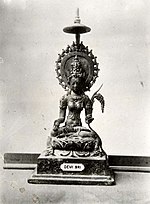Hantu is the Malay and Indonesian word for spirit or ghost. In modern usage it generally means spirits of the dead but has also come to refer to any legendary invisible being, such as demons. In its traditional context the term also referred to animistic nature spirits or ancestral souls. The word is derived from Proto-Malayo-Polynesian *qanitu and Proto-Austronesian *qaNiCu. Cognates in other Austronesian languages include the Micronesian aniti, Lio language nitu, Yami anito, Taivoan alid, Seediq and Atayal utux, Bunun hanitu or hanidu, Polynesian aitu or atua, and Tsou hicu among the Formosan languages. In terms of concept and place in traditional folklore, it is most similar to the Filipino anito.
Types
Aside from generic spirits of the dead, there exist various forms of Hantu including both the benign and malevolent.
- Hantu Air: spirit inhabiting the water
- Hantu Beruk: ape demon
- Hantu Belian: tiger spirit
- Hantu Musang: a civet cat spirit that is invoked in a game of possession
- Hantu Pusaka: grave demon
- Hantu Raya: great demon. This hantu is considered the strongest among evil spirits of the jungles of Malaysia, and takes the appearance of its owner.
- Hantu Rimba: deep-forest demon
- Hantu Tinggi: tall hantu that is associated with trees
See also
References
- Linguistik Indonesia (in Indonesian). Yayasan Obor Indonesia. p. 45. Retrieved 9 February 2017.
- Knappert, Jan (1992). Pacific Mythology: An Encyclopedia of Myth and Legend. Aquarian Press. p. 61. ISBN 9781855381339. Retrieved 9 February 2017.
- Bane, Theresa (2012). Encyclopedia of Demons in World Religions and Cultures. McFarland. p. 162. ISBN 9780786488940. Retrieved 9 February 2017.
- Julian Baldick, ed. (2013). Ancient Religions of the Austronesian World: From Australasia to Taiwan. I.B.Tauris. p. 3. ISBN 9780857733573.
- Leberecht Funk (2014). "Entanglements between Tao People and Anito on Lanyu Island, Taiwan". In Y. Musharbash & G.H. Presterudstuen (ed.). Monster Anthropology in Australasia and Beyond. Palgrave Macmillan. pp. 143–159. doi:10.1057/9781137448651_9. ISBN 9781137448651.
- ^ Skeat, Walter William (1965). Malay Magic: An Introduction To The Folklore And Popular Religion Of The Malay Peninsula. Psychology Press. p. 104. ISBN 9780714620268. Retrieved 9 February 2017.
- Brewster, Paul G. (1 January 1958). "The Malayan Hantu Musang and Other Possession Games of Indonesia and Indochina". Oriens. 11 (1/2): 162–176. doi:10.2307/1578932. JSTOR 1578932.
- Daniels, Kimberly (2013). The Demon Dictionary. Charisma Media. p. 151. ISBN 9781621363002. Retrieved 9 February 2017.
- Tajudin, Haji Zain; Lyman, Thomas A. "The Hantu Raya: a Malay Demon" (PDF). The Siamese Heritage Protection Program. Retrieved 9 February 2017.
- McHugh, James Noel (1959). Hantu Hantu: An Account of Ghost Belief in Modern Malaya. D. Moore. p. 123. Retrieved 4 October 2021.
| Legends | |
|---|---|
| Priestesses, shamans | |
| Types of Malay ghosts | |
| Malay saints | |
| Chinese spirit places | |
| See also | |
This Indonesia-related article is a stub. You can help Misplaced Pages by expanding it. |
This Malaysia-related article is a stub. You can help Misplaced Pages by expanding it. |
This article relating to a myth or legend from Asia is a stub. You can help Misplaced Pages by expanding it. |
